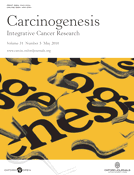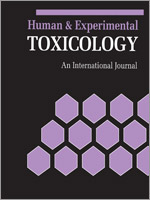
A carcinogen is any substance, radionuclide, or radiation that promotes carcinogenesis. This may be due to the ability to damage the genome or to the disruption of cellular metabolic processes. Several radioactive substances are considered carcinogens, but their carcinogenic activity is attributed to the radiation, for example gamma rays and alpha particles, which they emit. Common examples of non-radioactive carcinogens are inhaled asbestos, certain dioxins, and tobacco smoke. Although the public generally associates carcinogenicity with synthetic chemicals, it is equally likely to arise from both natural and synthetic substances. Carcinogens are not necessarily immediately toxic; thus, their effect can be insidious.

Arsenic poisoning is a medical condition that occurs due to elevated levels of arsenic in the body. If arsenic poisoning occurs over a brief period of time, symptoms may include vomiting, abdominal pain, encephalopathy, and watery diarrhea that contains blood. Long-term exposure can result in thickening of the skin, darker skin, abdominal pain, diarrhea, heart disease, numbness, and cancer.

Environmental health is the branch of public health concerned with all aspects of the natural and built environment affecting human health. In order to effectively control factors that may affect health, the requirements that must be met in order to create a healthy environment must be determined. The major sub-disciplines of environmental health are environmental science, toxicology, environmental epidemiology, and environmental and occupational medicine.
Genotoxicity is the property of chemical agents that damage the genetic information within a cell causing mutations, which may lead to cancer. While genotoxicity is often confused with mutagenicity, all mutagens are genotoxic, but some genotoxic substances are not mutagenic. The alteration can have direct or indirect effects on the DNA: the induction of mutations, mistimed event activation, and direct DNA damage leading to mutations. The permanent, heritable changes can affect either somatic cells of the organism or germ cells to be passed on to future generations. Cells prevent expression of the genotoxic mutation by either DNA repair or apoptosis; however, the damage may not always be fixed leading to mutagenesis.

A polycyclic aromatic hydrocarbon (PAH) is a class of organic compounds that is composed of multiple aromatic rings. The simplest representative is naphthalene, having two aromatic rings and the three-ring compounds anthracene and phenanthrene. PAHs are uncharged, non-polar and planar. Many are colorless. Many of them are found in coal and in oil deposits, and are also produced by the incomplete combustion of organic matter—for example, in engines and incinerators or when biomass burns in forest fires.
Toxicogenomics is a subdiscipline of pharmacology that deals with the collection, interpretation, and storage of information about gene and protein activity within a particular cell or tissue of an organism in response to exposure to toxic substances. Toxicogenomics combines toxicology with genomics or other high-throughput molecular profiling technologies such as transcriptomics, proteomics and metabolomics. Toxicogenomics endeavors to elucidate the molecular mechanisms evolved in the expression of toxicity, and to derive molecular expression patterns that predict toxicity or the genetic susceptibility to it.

Ochratoxin A—a toxin produced by different Aspergillus and Penicillium species — is one of the most-abundant food-contaminating mycotoxins. It is also a frequent contaminant of water-damaged houses and of heating ducts. Human exposure can occur through consumption of contaminated food products, particularly contaminated grain and pork products, as well as coffee, wine grapes, and dried grapes. The toxin has been found in the tissues and organs of animals, including human blood and breast milk. Ochratoxin A, like most toxic substances, has large species- and sex-specific toxicological differences.

Nickel(II) oxide is the chemical compound with the formula NiO. It is the principal oxide of nickel. It is classified as a basic metal oxide. Several million kilograms are produced annually of varying quality, mainly as an intermediate in the production of nickel alloys. The mineralogical form of NiO, bunsenite, is very rare. Other nickel(III) oxides have been claimed, for example: Ni
2O
3 and NiO
2, but they have yet to be proven by X-ray crystallography.

Carcinogenesis is a peer-reviewed medical journal in the field of cancer biology. It was established in 1980 and is published monthly by Oxford University Press. As of 2010, the editor-in-chief is Curtis C. Harris. Carcinogenesis publishes articles in four sections: cancer biology covers the cell and molecular biology of cancer, as well as mutation and DNA repair; molecular epidemiology includes genetic predisposition to cancer; cancer prevention covers chemoprophylaxis as well as dietary factors; and carcinogenesis covers all forms of carcinogens, including their metabolism and detection in the environment. Authors can pay to have their articles released freely online as part of a hybrid open access scheme. Free or reduced-rate online access is available to educational institutions in low-income countries.

Human & Experimental Toxicology is a peer-reviewed medical journal covering the field of toxicology. It was established in 1981 as Human Toxicology and obtained its current name in 1990. It is published by SAGE Publications and the editor-in-chief is Kai Savolainen.
Toxicological Sciences is a monthly peer-reviewed scientific journal which covers all aspects of research on toxicology. It is published by Oxford University Press on behalf of the Society of Toxicology. It was established in 1981 as Fundamental and Applied Toxicology and obtained its current name in 1998. The current editor-in-chief is Jeffrey M. Peters, a professor of molecular toxicology and carcinogenesis at The Pennsylvania State University, and the Managing Editor is Virginia F. Hawkins. The editorial staff also includes Associate Editors in subject areas and an editorial board of topic experts. While its ISO 4 abbreviation is Toxicol. Sci. it is commonly referred to as ToxSci.
Food and Chemical Toxicology is a peer-reviewed scientific journal covering aspects of food safety, chemical safety, and other aspects of consumer product safety. It is published by Elsevier and was established in 1963. The editor-in-chief is José L. Domingo.
Regulatory Toxicology and Pharmacology is a monthly peer-reviewed scientific journal which covers legal aspects of toxicological and pharmacological regulations. It is published by Elsevier on behalf of the International Society of Regulatory Toxicology & Pharmacology. The current co-editors-in-chief are Lesa L. Aylward and Martin van den Berg.

The Journal of Toxicology and Environmental Health is a peer-reviewed public health journal covering environmental toxicology. It was established in 1975 and in 1998 was split into Part A: Current Issues and Part B: Critical Reviews. According to the Journal Citation Reports, Part A has a 2012 impact factor of 1.733, whereas Part B has a 2012 impact factor of 3.896.
NeuroToxicology is a peer-reviewed scientific journal covering research on the toxicology of the nervous system. It was established in 1979 and originally published by Intox Press, until it was acquired by Elsevier in 2001. The editor-in-chief is Joan Marie Cranmer.
Archives of Environmental Contamination and Toxicology is a quarterly peer-reviewed scientific journal published by Springer Science+Business Media, covering environmental health and the effects of contaminants on the environment. It was established in 1973 and the editor-in-chief is Daniel R. Doerge. According to the Journal Citation Reports, the journal has a 2020 impact factor of 2.804.

Curtis. C. Harris is the head of the Molecular Genetics and Carcinogenesis Section and chief of the Laboratory of Human Carcinogenesis at the Center for Cancer Research of the National Cancer Institute, NIH.
Environmental Toxicology and Chemistry is a monthly peer-reviewed scientific journal covering environmental toxicology and environmental chemistry. It was established in 1982 and is published by Wiley-Blackwell in conjunction with the Society of Environmental Toxicology and Chemistry. The founding editor-in-chief was C.H. Ward, and the current one is G.A. Burton, Jr.. According to the Journal Citation Reports, the journal has a 2021 impact factor of 4.218, ranking it 117th out of 279 journals in the category Environmental sciences and 29th out of 94 in the category Toxicology.

Darlene Dixon is an American veterinary scientist and toxicologic pathologist researching the pathogenesis/carcinogenesis of tumors affecting the reproductive tract of rodents and humans and assessing the role of environmental and endogenous hormonal factors in the growth of these tumors. She is a senior investigator at the National Institute of Environmental Health Sciences.










